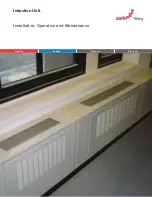
18
Cabinet Finish Maintenance
Use a fine grade automotive wax on the cabinet finish to
maintain the finish’s original high luster. This is especially
important in installations with extended periods of direct
sunlight.
Clean Outside Coil (Qualified Servicer Only)
The coil with the outside air flowing over it should be
inspected annually and cleaned as frequently as necessary
to keep the finned areas free of lint, hair and debris.
Condenser And Induced Draft Motors
Bearings on the condenser fan motors and the combustion
fan motor are permanently lubricated. No additional oiling
is required.
Lubrication
The fan shaft bearings, the supply fan motors, the
condenser fan motors and compressors are permanently
lubricated.
Functional Parts
Refer to the unit Parts Catalog for a list of functional parts.
Parts are available from your distributor.
TROUBLESHOOTING
THE FOLLOWING INFORMATION IS FOR USE BY
QUALIFIED SERVICE AGENCY ONLY: OTHERS SHOULD
NOT ATTEMPT TO SERVICE THIS EQUIPMENT.
Common Causes of Unsatisfactory Operation of Heat
Pump on the Heating Cycle.
Inadequate Air Volume Through Indoor Coil
When a heat pump is in the heating cycle, the indoor coil
is functioning as a condenser. The return air filter must
always be clean, and sufficient air volume must pass
through the indoor coil to prevent excessive discharge
pressure, and high pressure cut out.
Outside Air into Return Duct
Do not introduce cold outside air into the return duct of a
heat pump installation. For units with 2-speed motors, do
not allow air entering the indoor coil to drop below 65°F. Air
below this temperature will cause low discharge pressure,
thus low suction pressure, and excessive defrost cycling
resulting in low heating output. It may also cause false
defrosting.
Undercharge
An undercharged heat pump on the heating cycle will
cause low discharge pressure resulting in low suction
pressure and frost accumulation on the outdoor coil.
Poor “Terminating” Sensor contact
The unit’s defrost terminating sensor must make good
thermal contact with the outdoor coil tubing. Poor contact
may not terminate the unit’s defrost cycle quickly enough
to prevent the unit from cutting out on high discharge
pressure.
Malfunctioning Reversing Valve - This may be due
to:
1. Solenoid not energized
- In order to determine if the
solenoid is energized, touch the nut that holds the
solenoid cover in place with a screwdriver. If the nut
magnetically holds the screwdriver, the solenoid is
energized and the unit is in the cooling cycle.
2. No voltage at unit’s solenoid
- Check unit voltage. If
no voltage, check wiring circuit.
3. Valve will not shift:
a. Undercharged
- check for leaks;
b. Valve Body Damaged
- Replace valve;
c. Unit Properly Charged
- If it is on the heating
cycle, raise the discharge pressure by restricting
airflow through the indoor coil. If the valve does not
shift, tap it lightly on both ends with a screwdriver
handle. DO NOT TAP THE VALVE BODY. If the unit
is on the cooling cycle, raise the discharge pressure
by restricting airflow through the outdoor coil. If the
valve does not shift after the above attempts, cut
the unit off and wait until the discharge and suction
pressure equalize, and repeat above steps. If the
valve does not shift, replace it.
Содержание DBC Series
Страница 44: ...44...
Страница 45: ...45...
Страница 46: ...46 THIS PAGE IS INTENTIONALLY LEFT BLANK...
Страница 47: ...47 THIS PAGE IS INTENTIONALLY LEFT BLANK...
















































